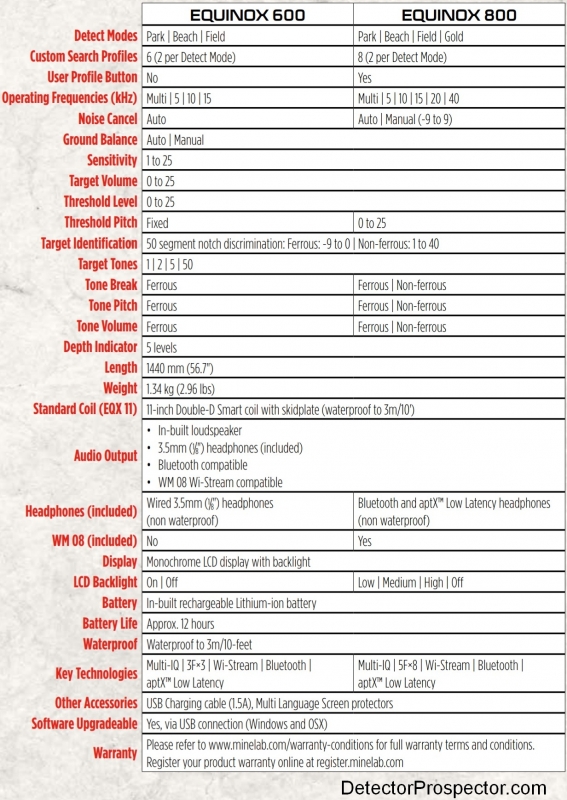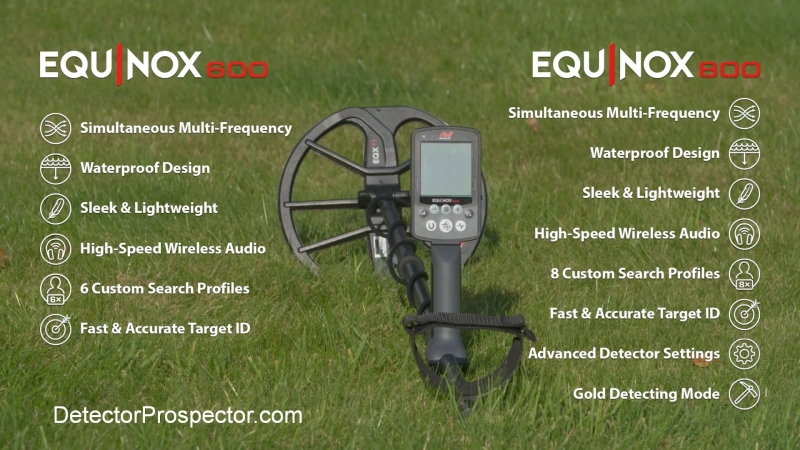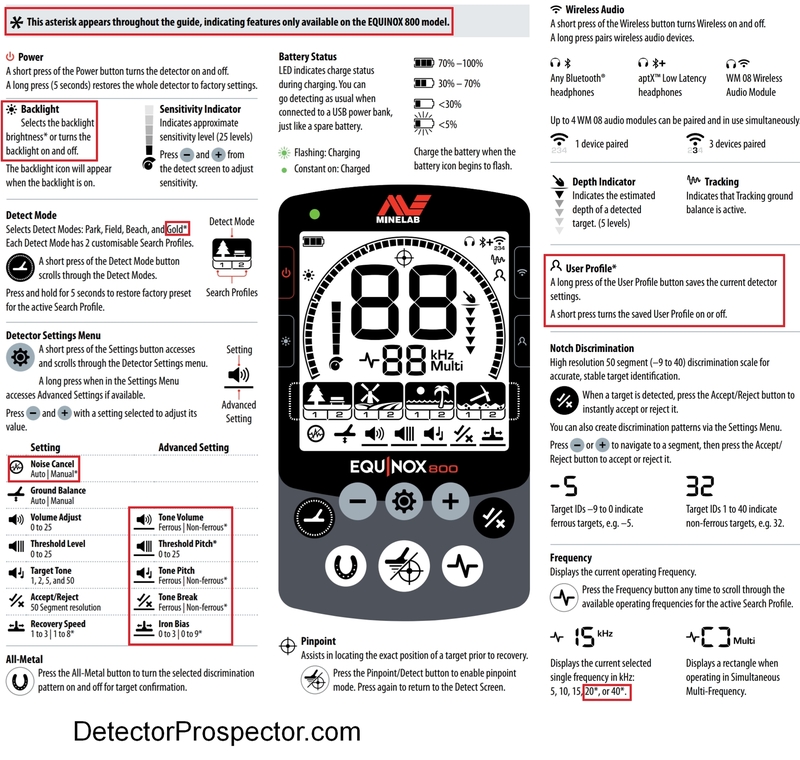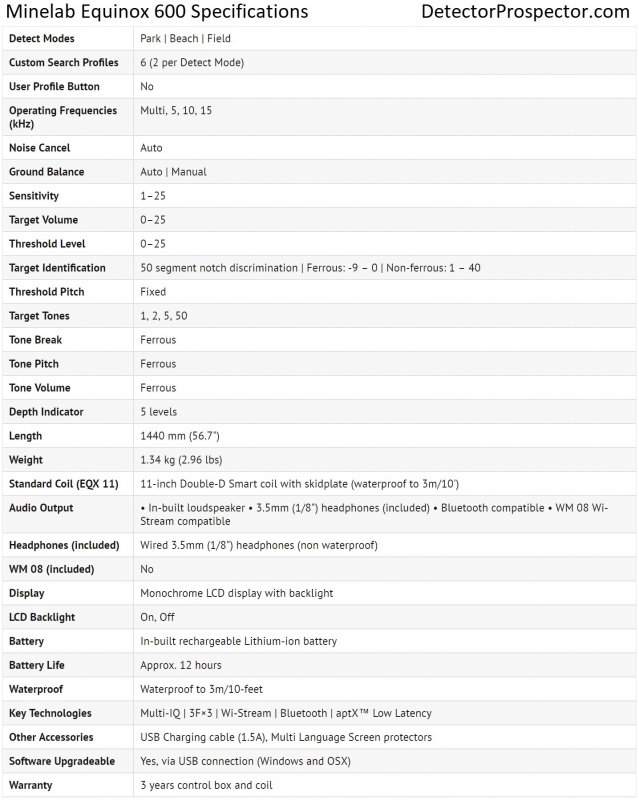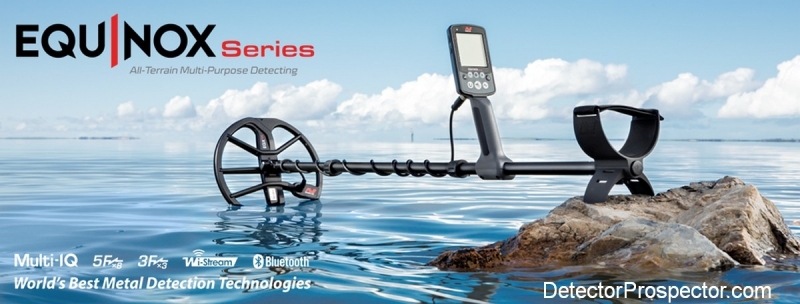-
Posts
19,761 -
Joined
Content Type
Forums
Detector Prospector Home
Detector Database
Downloads
Everything posted by Steve Herschbach
-
Hello Luis - welcome to the forum! I used Google Translate for this translation below. Your English is probably better than my Spanish! "Hello everyone, excuse me if it's not the right place, but I'm looking and I do not see the new members section. My name is Luis and I am from Spain. I have been following this forum for a long time and would like to continue learning from all of you as a registered user. Thanks and regards. Forgive my English, I am using a translator."
-

Equinox 600 Versus Equinox 800
Steve Herschbach replied to daryl curtis's topic in Minelab Equinox Forum
Hi Daryl, Welcome to the forum! Where the Equinox 600 and 800 share features they are identical, so no worries about any of the modes on the Equinox 600 being any less powerful than the same modes on the Equinox 800. Multi-IQ is identical on both models - there is no difference between the Equinox 600 and Equinox 800 in the Multi-IQ frequency range processed. The two obvious differences as touted in the poster below are the "Gold Detecting Mode" and the "Advanced Detector Settings". The Equinox 800 also comes with Bluetooth headphones and the WM08 wireless module instead of the wired headphones included with the Equinox 600, but those options can be added to the Equinox 600 if you desire. In fact many popular aftermarket Bluetooth headphones and even the Apple Air Pods will work with both of the Equinox models. OK, so the Gold Mode. This is a threshold based all metal mode running at either 20 khz, 40 khz or multifrequency (MF) that is intended for chasing very small items, like small gold nuggets or what is referred to as "micro jewelry" i.e. stud earrings, thin necklaces, etc. Gold Mode does not have different tones for different target types. Instead, it features what is referred to as VCO (Voltage Controlled Oscillator) audio where both volume and pitch change with target intensity. This is not a mode most people would use and unless you are nugget detecting or hunting beaches and tot lots for micro jewelry I am kind of doubtful that a person just starting out would have a use for that mode. More to the point, Multi-IQ processing is so good that the extra sensitive Park 2 and Field 2 mode common to both models is almost as good at finding small gold as the Equinox 800 Gold Mode. While serious nugget hunters will want every available tool, I know I could use the Equinox 600 to hunt gold and do as well or better than many single frequency nugget detectors. Do not underestimate the power of Multi-IQ. The Advanced Detector Settings is referring to the options marked with an asterisk in the image below from the Minelab Equinox 600 / 800 Getting Started Guide (click for larger version). I have highlighted the areas in question with a red box. The Equinox 600 allows you to turn the backlight on or off. The Equinox 800 has Low, Medium, High, or Off. This is only of interest to heavy users of meter backlights. Both Equinox models have automatic Noise Cancel functions but the 800 also offers a Manual override. If you hunt in areas of high electrical interference (EMI) or around lots of other detectors, this can be helpful in finding the quietest setting with the least interference. For normal use Automatic is actually very good however and is probably all most users will need. The Equinox 600 features three level of Detect or Recovery Speed (Reactivity on a Deus). Low settings are better for areas with sparse targets, high settings for dense trash. The Equinox 800 has eight levels for finer tuning in the densest "carpet of nails" scenarios. Low settings offer more solid hits on very deep targets, but poor separation of closely adjacent targets. High settings have great separation, but the clipped audio responses required in dense trash make it harder to hear very deep targets. Use a setting as low as possible that achieves the desired target separation. The Equinox 800 has a User Profile button that allows the operator to jump straight to an alternative Detect Mode. This can take multiple button pushes on the Equinox 600. For example, to get from Park Mode 1 to Beach Mode 1 takes four pushes of the Detect Mode button to cycle there. An Equinox 800 user can program the User Profile for a jump there in one button push. Nice but this is just a convenience feature. There are of course the 20 kHz and 40 kHz single frequency options on the 800 that are lacking on the Equinox 600. These two extra single frequency options are available on the Equinox 800 in the Park, Field, and Gold Modes but not the Beach Mode, which is multifrequency only. Again, in my opinion the real power of Equinox is Multi-IQ, so the Equinox 600 lacking these extra frequency options is likely to prove to be of little consequence for most people. To reiterate - Multi-IQ is identical on both models. There is no difference in the Multi-IQ frequency range processed between the Equinox 600 and Equinox 800. Most metal detectors work such that all target tones have the same volume. A relatively new feature allows some detectors to set the volume of the ferrous (iron and steel) tones to be lower, which can be much easier on the ears in locations full of ferrous trash. Both the Equinox 600 and 800 can adjust the ferrous tone volume. This is particularly useful in the two tone mode, where one tone is normally ferrous and everything else a different tone. The Equinox 800 goes a step farther in allowing even non-ferrous tone volumes to be adjusted. Maybe you have coins set to give a high tone, but you have a hearing loss in the high tone range. The Equinox 800 allows you to increase the volume of the high tone response in relation to the other tones, making it easier to hear. This is most useful in the five tone mode. Both the Equinox 600 and 800 allow you to set the threshold level volume, but the Equinox 800 also allows you to set the threshold pitch or tone. Again, this is good for people that have hearing loss issues in particular ranges. The tones used in Single Tone, Two Tone, Five Tone, and Fifty Tones come factory preset on both models, but the Equinox 800 allows you to change the pitch of these tones also via the Tone Pitch setting. Finally, there is Tone Break. The positions on the target id scale where one tone shifts to another is factory preset. Both the Equinox models let you adjust the point where ferrous tones shift to non-ferrous tones - a very important feature. However, with the Equinox 800 the other non-ferrous audio controls really come together knowing you can also adjust the break points between the non-ferrous tones. This means you can create totally custom audio discrimination modes on the Equinox 800. 50 tone mode is exempt, so this is most useful in five tone mode. You can move the break points around as you please with the Equinox 800, and even use this to create four tone and three tone modes. You can move a couple target id segments to both read in the ferrous range and assign them a similar tone for instance, so two of the tones will be ferrous, and the three remaining tones assigned to non-ferrous items as the operator pleases. This is an incredibly compelling feature for people like me that hunt almost entirely by ear with the target id numbers only coming into play after the fact. Still, more of an advanced user function for sure, which is why only the Equinox 800 has these options. The thing is all these tone setting options do not really make the machine detect deeper. Advanced users or people with poor hearing appreciate these things, but the options on the Equinox 600 are still quite good. The bottom line? The Equinox 600 is really all most normal people would need and even then it has more features than most detectors. With the exception of Gold Mode both Equinox models will find targets equally well. The people who want the extra features on the 800 generally know who they are. If you are worried about it and not sure, only $250 can allay those fears! The discussion of audio options above may be confusing for some. It is very hard to put into words what a video may show in minutes. The following video does a good job of illustrating the advanced audio customization features on the Equinox 800. Finally, here is a post elsewhere on the forum by another person explaining all this in their own way, which may also help. 3/23/18 New blog on the subject - https://www.minelab.com/anz/go-minelabbing/treasure-talk/equinox-600-vs-equinox-800 -

GPZ 7000 Audio Problems After Latest Update
Steve Herschbach replied to mlgdave's topic in Minelab Metal Detectors
You can go back to the old firmware version no problem. You can download all prior versions from the bottom of this page. -

Nokta Impact V1.16 Update Available
Steve Herschbach replied to Steve Herschbach's topic in Nokta / Makro Metal Detectors
Hmmmm... if you mean download to your computer, I just did that with the file and no problem with my PC. If you mean it did not load properly into the Impact - that I can't verify but I will see if we can't find somebody else who can. A regard headphones the update has this warning: "IMPORTANT! If you do not have the RED EDITION of the 2.4GHz wireless headphones but an older version and would like to upgrade your detector with this software version, please check the WiFi channel of your detector first and make sure that it is NOT set to channel 4 or 5 but to one of the channels between 0-3 before uploading the software to your detector!" -

Equinox Battery Replacement Program?
Steve Herschbach replied to MontAmmie's topic in Minelab Equinox Forum
Another response from Minelab: “The Li-ion battery in the EQUINOX detectors is easily replaceable. Minelab has not yet released official information as to whether or not a user can change the battery over without voiding warranty or if we recommend the battery is changed by a dealer or service centre. Further information about battery care and maintenance will be provided in the EQUINOX Instruction Manual, which has not been released yet. This will be available when the product is available. The EQUINOX detectors are not designed to run from AA batteries. However, you can use a standard USB power bank (as you do with mobile phones) to recharge the built-in battery and operate the detector at the same time.” -

Video - MX7 Features Explained
Steve Herschbach replied to Steve Herschbach's topic in White's Metal Detectors
I assume the M6 at the same price will not be around much longer. -

Question For The Experts - GPZ Noise Cancel
Steve Herschbach replied to normmcq's topic in Minelab Metal Detectors
Brilliant JP - I never thought about the fact that detectors that use wireless headphones might interfere with each other if on the same channel. Something to be aware of as more and more detectors go to wireless audio. -

SDC 2300 - Is It Dead?
Steve Herschbach replied to GoneBushForever's topic in Minelab Metal Detectors
The reality in detector land (or forums at least!) is that we are endlessly attracted to the latest new shiny object. There is a pattern with Minelab. New model introduction. Detractors pile on, say no way. Large debates ensue. A year later everyone owns one and the question has been more or less settled. So we move on to the next new model and start over. The buzz at the moment is the Equinox. New detector, same old story. -

Equinox Battery Replacement Program?
Steve Herschbach replied to MontAmmie's topic in Minelab Equinox Forum
Nothing is perfect. When you design a detector everything's a trade off. Battery compartments are the classic leak point in waterproof detectors. You only have to get an improper seal once to flood the battery compartment and /or detector. Waterproof detectors have abnormally high failure rates and warranty issues in part due to this. The CTX could be considered a classic example of concerns over battery seals. I have used lots of waterproof detectors, and every time I seal the battery compartment I cross my fingers. No matter how careful you are there is always a little risk involved. It's also a pain. My ATX I have to charge the batteries every two days. There are two battery doors. Every two days, pull batteries in evening to charge, and clean o-rings and door seal areas. Put back together in morning and hope I got it right. With Equinox just attach the magnetic charger and you are good to go in the morning. Dealing with battery compartment seals is a low level ongoing job with most waterproof detectors that I will not miss. The reality is the Equinox is designed for the future, not the past, and new detectorists in particular are used to owning things that need to be charged regularly. Lithium Ion battery technology is vastly improved now, and if Minelab says that they expect the battery life to exceed three years under normal use then I am taking them at their word for it. The catch of course is what defines "normal". Normal detectors are sitting in closets getting no use. If I am out detecting like crazy, normal does not apply. Maybe the battery will only make it to two years in my case. Don't know, as only time will tell, but the benefit here is compelling. On the other hand having a battery built into the coil is a no-go. Wireless signals do not normally transmit underwater, and so the Deus coil, for example, loses the connection with the controller or headphones when the coil is submerged. The solution is to run an antenna wire from the coil up to a point above the water or, if the control box is to also be submerged, to the control box. Wireless also turns $200 coils into $400 coils and limits coil availability. On the Deus, sold as a dry land detector, this can still make sense. But for a detector sold for use in water wireless coils make no sense at all. The thing is that these are design choices that get made in every detector, and the Equinox has its share. For some people (me!) the design choices make sense. Others will feel just the opposite, and that's fine. That is why other detector models exist - so we have choices. -

SDC 2300 - Is It Dead?
Steve Herschbach replied to GoneBushForever's topic in Minelab Metal Detectors
The SDC 2300 is not even remotely dead! In fact if you take the price out of the equation, it is the number one machine I would like to see complete newbies get as a first gold nugget detector. It is remarkably simple to run, and if any little bits of gold remain in mineralized ground to be found, the SDC will find them. It's one of those detectors that can find gold when nothing else can. The only catch is that in real mild ground a hot VLF like a Gold Monster does very well also. In my case it's actually simple. Once I got a GPZ 7000 my SDC 2300 was going unused. I usually am in fairly moderate ground and I run the GPZ as hot as it can run. It hits gold not quite as small as the SDC, but it punches far deeper on larger bits. Now, I might miss some tiny bits, but keeping a $3000 detector around to clean up tiny bits is over the top even for me. For the ground I am on the Gold Monster serves a similar task for far less money, with the added bonus of ferrous discrimination. I am not saying the Gold Monster is better than the SDC 2300. It is a factor of ground mineralization and money and how much the machines will get used. Gold Monster $799 <------------------------------------> SDC 2300 $3750 Low Mineral Ground <---------------------------------> High Mineral Ground In low mineral ground the Gold Monster excels but as the mineralization increases, its performance suffers. The SDC retains far more capability under the most adverse conditions and so is the better choice in extreme ground. Somewhere in the middle there is a vague crossover point between the two. What you are really paying for in the SDC 2300 is not the ability to find small gold, but to resist extreme mineralization and hot rocks that foil the VLF detectors. The Gold Monster makes more sense for me given my situation, and the fact it is half the weight of the SDC just seals the deal. If I was on bad ground chasing small gold more often the equation would change in favor of the SDC. What I really want is a dry land SDC in a light weight package at a lower cost, with accessory coils! -
I certainly did not say there is no market for more expensive detectors that have features that justify the price. My point is made purely in reference to the huge number of single frequency VLF detectors, and that would certainly include most of the First Texas stable of detectors. With the ever increasing number of models from companies, especially flooding the 13 - 19 kHz segment, it was only a matter of time before a shakeout occurred. I think Nokta/Makro was more the start of it than anyone. There has been a parity for years where a 14 kHz White’s MXT at $799 set a performance / price point. For what seemed like ages I described $799 as a bang for the buck “sweet spot” because every company has a great mid-frequency do-it-all machine near that price. You could price almost any detector by comparing it to the $799 models and seeing how it fit into the equation. Lower price and higher price models came along, but that $799 price point was very resistant to change for a long time. I would now say that $499 is shaping up as the new “bang for the buck” single frequency VLF price point with $599 for more deluxe models. 15 kHz Garrett AT Pro $552 19kHz Fisher F19 $449 14 kHz Makro Standard Racer $499 18.75 kHz Minelab X-Terra 705 $499 13 kHz Teknetics T2 Classic $499 14 kHz White’s MX7 $549 The whole mid-frequency (teens) VLF segment has been so flooded with models that for the last two years all I could think about each new introduction has been "just another mid-frequency detector". They are good detectors, no disputing that, but single frequency really is old tech at this point and any decent engineer can make a very good single frequency VLF detector. The Chinese have been remarkably slow to get up to speed with metal detectors compared to other consumer products. They have cornered the market in counterfeits but have yet to make a serious impact with legitimate detector models. That also is changing and I will not be surprised to see very good, very low cost detectors from China also putting pressure on the low end. Another trend just showing the tip of its nose is the decision by Teknetics to emphasize factory direct sales over dealer sales. The Teknetics website has been refashioned as TekneticsDirect.com "Factory Direct Sales Of Metal Detecting Equipment". I floated the idea of somebody doing the factory direct thing for years - in fact I suggested it to Troy Galloway a long time ago. It would have helped the Troy detector problem of too many fingers in the pie and resulting uncompetitive pricing. Tesoro was another brand that could have gone that way as they lost dealer shelf space. Just cut out the dealer and sell online for dealer cost, bring prices down dramatically. This looks to be the new Teknetics model going forward and it can also act to pull prices down if it catches on. It is ironic that the company that for so long did nothing but push prices higher that Minelab has made such a dramatic turn around and has in fact now become the outfit pushing prices lower. I guess they saw the writing on the wall and instead of fighting the industry shakeout decided to trigger it.
-
Welcome to the forum! Controversy is fine but be forewarned that forum rules are vigorously enforced
-
I authorized Minelab to publish an edited version of a couple forum posts I made that may not make other manufacturers very happy. In a nutshell I say that with the Equinox 600 feature list and $649 price tag, why would anyone pay more than $600 for any run of the mill single frequency detector, no matter how good? Assuming the Equinox performs of course, which I am extremely sure is not an issue Some people may take issue with that but it is honestly how I feel about it, so check it out at https://www.minelab.com/go-minelabbing/treasure-talk/minelab-equinox-unprecedented-anticipation And got a plug in for the new forum!!
-

Depar Dpr 600 - New Gold Detector By XP
Steve Herschbach replied to Steve Herschbach's topic in XP Metal Detectors
I would appreciate people not making inflammatory statements directly attacking other individuals by name via this forum. I have blanked out the individual's name in your post. The DPR 600 features can be determined by reading the Owner's Manual -
There is finally a page on White’s website dedicated to the new MX7 https://www.whiteselectronics.com/product/mx7/?lang=us And a new video with Steve Howard showing the various MX7 settings options.
-
We at History Seekers are joined by Russ Balbirona from First Texas Products to talk about the new pinpointers plus tidbits on the new T2+ and F75+. If you are a Fisher Research Labs or Teknetics Metal Detectors fan, this is a show that you do not want to miss. Note: this is a podcast recording of the 11/15/2017 show. After listening to it there was more about the pinpointers than the T2+ and F75+. In fact other than mention of a possible transferable warranty (they are vague on that point) there really is nothing new about the two models. Also a mention of new stuff in the next couple years.
-
Since Minelab is a publically traded company not all this stuff is secret. It took Minelab about five years and approximately $10 million to develop the GPZ 7000. That is just development. Then add in manufacturing, distribution, advertising, etc. http://www.detectorprospector.com/forum/topic/2703-cost-to-develop-gpz-7000-over-10-million/ I don't care what companies charge for products I don't have to own. I can choose to buy them or not. No point in getting mad at Maserati because they charge more for cars than I want to spend!
-
Welcome to the forum! Pictures very welcome here and work best uploaded directly to your post. I personally would be very curious to hear about your use of the GPX 5000 in the UK.
-

Five Frequency Times Eight
Steve Herschbach replied to Steve Herschbach's topic in Minelab Equinox Forum
Detector manufacturers often make one main board for manufacturing volume and efficiency. The top model has all the features activated. Less expensive models they simply limit access to some features, but it is the same detector under the hood. For instance, a White's VX3 is the same circuit board as a V3i with a few features turned off. However, it is not a matter of going in and flipping a switch - the limitations are usually encoded in the firmware. A basic $499 Fisher Gold Bug is the same as a Gold Bug Pro internally. They just took away your access to the manual ground balance. Everyone does it and not just in the detector industry. -
Very nice! I am finally easing back into serious coin detecting after years of silver being sidelined in favor of gold. Hopefully I will have some nice silver to show soon.

